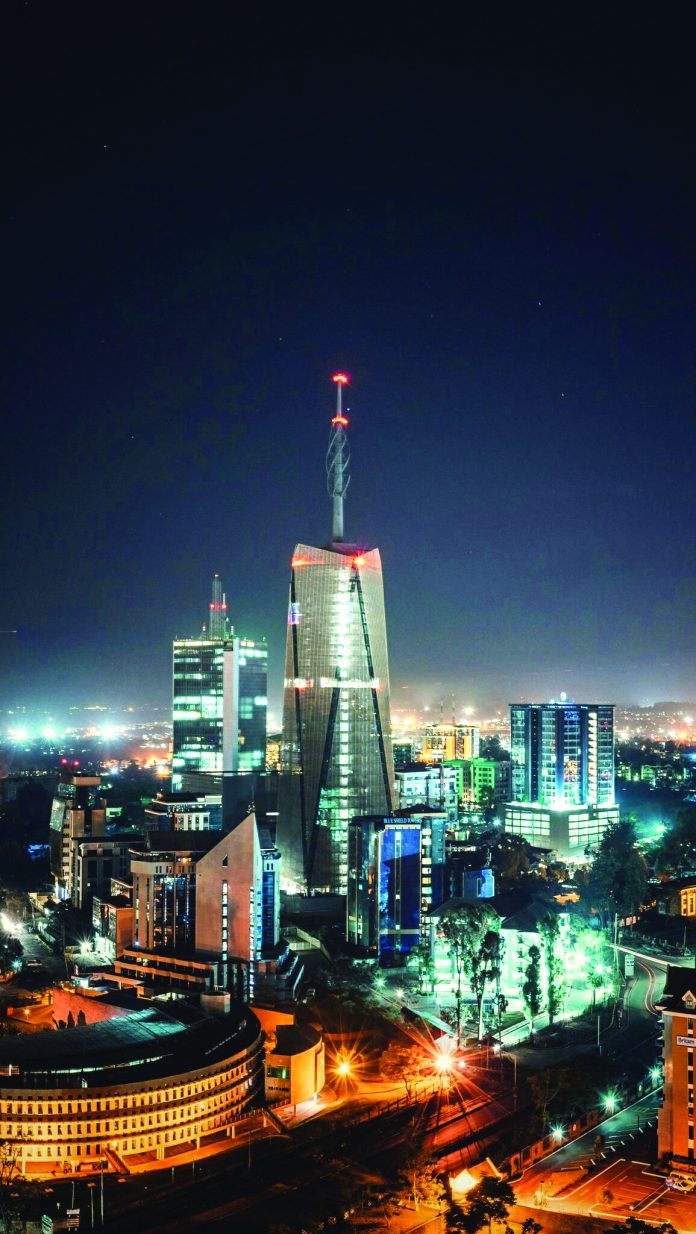Nairobi, a boiling point of cutting edge innovation is a city of firsts. It’s the only city in the world that has a national park within the city; the Nairobi National Park. It’s easy to see why the city’s poster image is that of giraffes photographed against the backdrop of sky hugging skyscrapers.
It’s one of these skyscrapers that has etched the city’s name in the world map of architectural excellence; the Britam Tower.
Completed in 2017, the skyscraper recently won the prestigious Emporis Skyscraper Award, on the strength of its quality, world beating features.
Emporis judges found it fit to be the continent’s top skyscraper, and the b 10th in the world, beating an élite pool of over 250 buildings.
One of the key aspects that the Emporis judges looked at was the building’s design and functionality. It ticked all the right boxes, and for a good reason.
The 200-metre Britam Tower sits on 1.5 acres on Hospital Road, Upperhill and comprises two separate buildings: a 31-storey office tower and a 15-storey parking silo with an interlinking bridge at the top floor which offers alternative means of evacuation at emergency situations.
It was also voted for its green aspects, including energy efficiency. The skyscraper was designed by GAPP Architects & Urban Designers and Triad Architects.
The green buildings concept is gaining widespread popularity in Kenya, as the skyline keeps on changing, thanks to new skyscrapers with fresh, bold, designs. According to experts, environmentally sustainable buildings are ones whose construction and operation assure the healthiest possible environment for its inhabitants, while representing the most efficient and least disruptive use of land, water, energy and resources. As the world starts to feel the heat of the negative effects of climate change, experts in the build environment are calling for green designs.
What features does an environmentally sustainable building have?
According to Leadership in Energy and Environmental Design (LEED), a rating system created by the U.S. Green Building Council (USGBC) green buildings are ones that have the following environmental and energy aspects.
Their developers should prevent pollution during construction. Further, the buildings should have an alternative transportation for building occupants, community connectivity, water use reduction, energy performance tracking, refrigerant management, promotion of sustainable building materials, habitat restoration and open space protection, and improved indoor environmental quality.
Even as the concepts gains roots in Kenya, not many buildings can be considered as green.
Kenya’s Energy Management Awards through its new category, Green Building Award, found only nine buildings to be environmentally sustainable.
9. Leven House, Mombasa

Named after a British naval ship, the HMS Leven, the building was used by officers from the ship as an anti slavery base when they visited Mombasa in 1824.
In 2010, the building got a new lease of life after it was renovated by the Museums of Kenya and the Mombasa Old Town Conservancy Office.
The Green Building panel was impressed by the building’s optimal orientation consisting huge window facades in the north and south-facing walls, perfect for coastal climate.
It uses local materials and technology and a natural ventilation system, making it one of Kenya’s truly green buildings.
8. Manda Airport, Lamu

Manda Airport in Lamu is an architectural marvel that was designed by Adventis Inhouse Africa. The terminakl building hosts a number of photovoltaic solar panels that power the airport. It’s not surprising that it’s perhaps the only terminal that is fully powered by solar energy.
Other key features of the airport terminal include; a natural ventilation system, natural lighting system, waste water recycling technology, and light-colored walls that has high thermal mass for cooling.
7. Uaso Nyiro Primary School
Tucked in Segera in the semi-arid bowels of Laikipia County, Uwaso Nyiro Primary School is one of the two greenest schools in the world, according to the US Green School Building Council. The other school is in Hong Kong.
Uaso Nyiro school stands out for its impressive water harvesting technology. The school collects up to 350 000 litres of water every year, which is then filtered using a unique clay based system before its stored in an underground tank.
It’s design is also hailed for incorporating natural lighting and ventilation systems, as well as having lots of green areas throughout the building.
6. Red Pepper House, Lamu
You cannot talk about breathtaking architecture in the coastal strip without mentioning the Red Pepper House. The building features a makuti roof that blends perfectly well with the surroundings. Inside, it has no walls, allowing guests to immerse themselves into the pleasant coastal climate. It also has photovoltaic solar panels for water heating and other power related activities, and large shaded areas that cool the internal spaces.
What’s more, the building is made using locally available materials and recycled materials, so there was not much interference with the environment during construction. It was designed by Urko Sánchez Architects.
5. Strathmore University, Phase III
This iconic building is oriented to the climate of the surrounding areas. It has major window facades facing the north and south walls to prevent excess glare to users. Furthermore, it incorporates sun shading on all windows, with natural lighting and ventilation reducing its energy usage by a huge margin. Designed by Lexicon Architects, the building also features a natural cooling tower and high thermal mass walls.
Other standing out features of this building include; waste water recycling technologies, a water harvesting system, light exterior colors that reflect solar radiation, and a permeable landscape.
4. Unep Building, Nairobi

If you’re looking for one of the greenest buildings in the world, look no further than the UNEP building in Gigiri. It houses the UNEP offices and the UN-Habitat Headquarters and is part of UN’s Greening the Blue Initiative.
It has automated low-energy workspaces, energy-efficient computers, rain water harvesting systems, water saving taps and lavatories.
It’s central atrium and light wells maximize natural air flow throughout the building.
3. Oleleshwa Primary School, Ewaso Ng’iro

It’s not everytime that you encounter a school that incorporates cultural themes in its buildings, but Oleleshwa Primary School is perhaps one of the few that do it.
Designed by Geoffrey Wasonga, the school’s architecture borrows heavily from the Maasai culture. It was completed in 2013.
It’s considered one of the greenest buildings because of its major window facades in the north and south facing walls. With this design, the pupils can learn peacefully without worrying about the glare of the sun. One of its key features is the Maasai hut design, which has large shaded areas, natural ventilation and lighting, waste water recycling technology and rain water harvesting techniques.
It uses local and recyclable materials.
2. Coca Cola East and Central Africa Business Unit, Nairobi
This iconic building is hard to miss. Located in the heart of Upperhill, Nairobi, the ultramodern building is a fine collaboration between Triad Architects and GAPP Architects &Urban Designers (SA).
A bird’s eye view of the building reveals a “C” shaped design, depicting the company’s logo.
Given its clear windows with a north-south orientation, the building allows lots of natural lighting to filter in, while keeping direct sunlight at bay. This design eliminates the need for air conditioning systems.
Furthermore, it features a rooftop lawn that eliminates heat gain.
With photo-sensor lights that turn on and off automatically, energy efficiency is one of its stand out features. An innovative water harvesting technique that collects up to 50 000 liters of water adds to its green allure.
1. Learning Resource Centre, Catholic University of Eastern Africa

The center comprises a bookshop, a modern conference hall, an extensive library and a cafeteria. It’s known for its unique air cooling systems that make it one of the most environmentally friendly buildings in Kenya.
For instance, its conference hall features an intricate cooling system that allows cold air to enter the building through vents. Once in, it passes over a bedrock which cools it further before it’s released into the auditorium. The center stands out for its use of a rock bed; In Kenya, it’s the only building that coolsair using a bedrock. All this is done through use of vents. Foul air is expelled from the building by use of thermal chimneys.
The building also features oxidation ponds for sewerage management.
It was designed by Architect Musau Kimeu.
Bonus project; The ASILONG CHRISTIAN HIGH SCHOOL, ASILONG, WEST POKOT, KENYA

The school is not just an envirnomnetally sustainable building but a beacon of promise for a community in West Pokot County. It’s story begins with a community that dreamt of a peaceful coexistence, through access to clean water. The community sought to enhance educational opportunities for primary school pupils.
The project is a high school campus that will educate 320 students upon full buildout. Structures accommodate classrooms, offices, dormitories, and teacher housing at its core.
The local conditions are harsh by any standard: drastic seasonal swings between dry seasons with harsh equatorial sun and wet seasons with pronounced rainstorms that erode the dry, sparsely planted land with no connection to a municipal water or power system.
Design constraints and opportunities are dictated by the place: zero net energy, zero net water, emphasis on regional materials and local labor, and community engagement to ensure generational success.
Designed by BNIM Architects, it recently won the COTE Top Ten Awards, the industry’s best known awards program for sustainable design excellence.



















